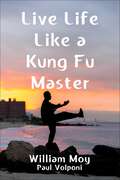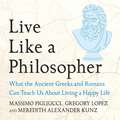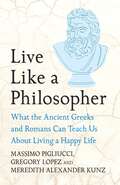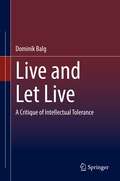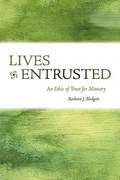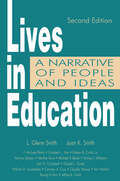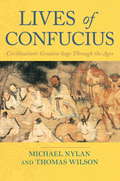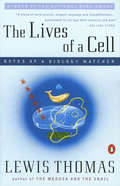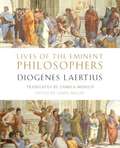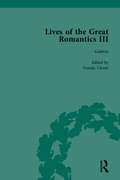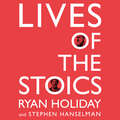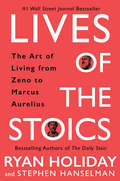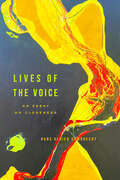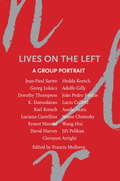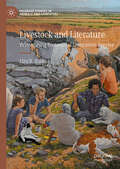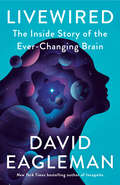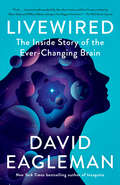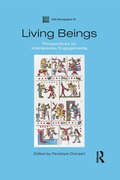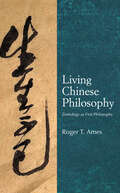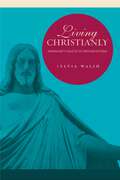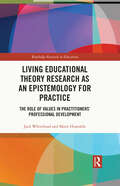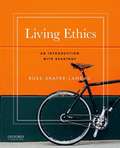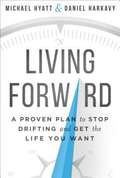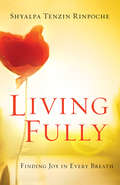- Table View
- List View
Live Life Like a Kung Fu Master
by Paul Volponi William MoyLive Life Like a Kung Fu Master is William Moy&’s personal invitation to become your teacher or &“sifu,&” as he presents over twenty attributes/techniques that will contribute to living a life made better by possessing Kung Fu. Attributes such as balance, structure, distance awareness, relaxation and traveling the shortest route between two points are presented both in terms of self-defense and in making an impact on your daily life—at home, school, work, business and social encounters. The text also features positional sketches drawn by William, as well as links to a number of videos in which William demonstrates physical techniques for students to model. William is joined on this literary Kung Fu journey by this long-time student and disciple, multi-award-winning author Paul Volponi. In turn, the co-authors are joined by several renowned martial artists, including Sammo Huang, Karen Sheperd, Grandmaster Tak Wah Eng, Grandmaster Doc-Fei Wong and Sifu Leo Imamura. A score of contributors such as basketball Hall of Famer Dave Cowens, two-time Olympic Gold medalist Kayla Harrison, glass-ceiling breaking baseball pitcher Ila Borders, famed tightrope walker Denis Josselin and World Scrabble Champion Joel Wapnick discuss how the attributes of Kung Fu relate to their many successes. The term &“Kung Fu&” actually translates as "time and effort equals a skill." That's why you see establishments with names such as Kung Fu Bread and Kung Fu Tea. These proprietors are not trumpeting their ability to fight. Rather, they're saying, we put in the time to study and learn our craft, and the result is that we are masters in our own arena—baking bread or brewing tea. In Asian culture, people who are said to have "good Kung Fu" have a handle on their lives. They are honest, direct, kindly and self-assured. These are values more highly prized than the ability to fight. What&’s the parallel between these prized qualities and the ability to physically defend yourself like a martial arts Kung Fu master? Kung Fu, especially Wing Chun Kung Fu, is based on a center-line theory of taking the shortest path, a straight line between two points, in defending yourself. It is also based on calmness and relaxation, enabling the practitioner to feel and quickly interpret incoming forces—therefore, bringing about a swifter and more focused reaction. Cultivating such abilities will allow you to transfer their martial benefits onto daily situations in your personal, social, and business interactions. William Moy&’s view of the teacher/student relationship is a simple one: &“Your sifu&’s role is to help you find your own Kung Fu.&” Hence, there are no cookie-cutter students. Each journey will be inherently different depending upon the individual student&’s physical attributes, personality and goals. In this very patient art, there are no failures, just students continuing on a path to their desired destination.
Live Like A Philosopher: What the Ancient Greeks and Romans Can Teach Us About Living a Happy Life
by Massimo Pigliucci Gregory Lopez Meredith Alexander KunzA wide-ranging philosophical and practical guide to incorporating the wisdom of ancient philosophers into daily modern life.What does life truly mean? Who do I want to become? And how do I get there? These are some of life's biggest questions that can be hard to think through. Fortunately, a group of philosophers from ancient Greece and Rome have already done a lot of the heavy lifting. Drawing on the philosophies, life lessons and experiences of key thinkers, Live Like a Philosopher will help you navigate these existential waters with invaluable insights for modern life.From finding balance with Aristotle and embracing uncertainty with Cicero to avoiding pain with Epicurus and learning how to rebel with Cynic Hipparchia, this is a powerful toolkit to help you navigate the highs and lows of modern life. Organized around three main themes of pleasure, virtue, and doubt, there's something to learn from each master in this philosophical quest. Live Like a Philosopher is the helping hand we all need to make life better.
Live Like A Philosopher: What the Ancient Greeks and Romans Can Teach Us About Living a Happy Life
by Massimo Pigliucci Gregory Lopez Meredith Alexander KunzA wide-ranging philosophical and practical guide to incorporating the wisdom of ancient philosophers into daily modern life.What does life truly mean? Who do I want to become? And how do I get there? These are some of life's biggest questions that can be hard to think through. Fortunately, a group of philosophers from ancient Greece and Rome have already done a lot of the heavy lifting. Drawing on the philosophies, life lessons and experiences of key thinkers, Live Like a Philosopher will help you navigate these existential waters with invaluable insights for modern life.From finding balance with Aristotle and embracing uncertainty with Cicero to avoiding pain with Epicurus and learning how to rebel with Cynic Hipparchia, this is a powerful toolkit to help you navigate the highs and lows of modern life. Organized around three main themes of pleasure, virtue, and doubt, there's something to learn from each master in this philosophical quest. Live Like a Philosopher is the helping hand we all need to make life better.
Live and Let Live: A Critique of Intellectual Tolerance
by Dominik BalgTolerance - desired by many and often demanded: By UNESCO, by the Pope, by Angela Merkel and Barack Obama. But what exactly does it mean to be tolerant? Does tolerance imply rejection? Or is tolerance merely the opposite of dogmatism? And how does a tolerant attitude differ from an indifferent one? Dominik Balg, starting from a well-founded explication of the concept of tolerance, subjects a tolerant attitude as an intellectual attitude toward conflicting opinions to a detailed critique and discusses the plausibility of general tolerance claims in specific domains such as politics, religion, or ethics. He considers possible alternatives to a tolerant attitude and presents with intellectual open-mindedness and humility two substantial attitudes that can be clearly distinguished from a tolerant attitude and - in contrast to tolerance - can also be easily demanded on a general level. - With a foreword by Thomas Grundmann. This book is a translation of the original German 1st edition Leben und leben lassen by Dominik Balg, published by J.B. Metzler, an imprint of Springer-Verlag GmbH Germany, part of Springer Nature in 2020. The translation was done with the help of artificial intelligence (machine translation by the service DeepL.com). A subsequent human revision was done primarily in terms of content, so that the book will read stylistically differently from a conventional translation. Springer Nature works continuously to further the development of tools for the production of books and on the related technologies to support the authors.
Lives Entrusted: An Ethic of Trust for Ministry (Prisms Series)
by Barbara J. BlodgettThis book is about communities of faith and their leaders, and it argues that they should better learn how to practice trust. The book comprises five chapters. Chapter 1 defines trust and explains how it works between individuals and within communities. Chapter 2 takes up the issue of confidentiality in the ministry. Chapter 3 draws upon the work of Michael Power on the proliferation of "audit societies." Chapter 4 addresses gossip, and Chapter 5 deals with the temptation of clergy to bullshit.
Lives in Education: A Narrative of People and Ideas
by Joan K. SmithThis volume presents the history of Western education through the biographies of some 70 individuals, past and present, who exemplify the education of their times or have made important contributions to the development of educational theory or practice. In so doing, it links major issues and ideas in education to key historical personalities. Each chapter includes substantive background information, a summary, and chapter notes.
Lives of Confucius: Civilization’s Greatest Sage Through the Ages
by Michael Nylan Thomas WilsonIn a biography that fills in gaps in the life of Confucius/Kongzi (551-479 BC), Nylan (early Chinese history, U. of California at Berkeley) and Wilson (history, Hamilton College, Clinton, New York) trace the life and evolution of thought of the Middle Way philosopher from his inauspicious beginnings to veneration as a sage whose ideas on personal and government morality are still influential. They also discuss his critics and followers, and include a summary chart of American perceptions of the Chinese...
Lives of a Cell: Notes Of A Biology Watcher
by Lewis ThomasElegant, suggestive, and clarifying, Lewis Thomas's profoundly humane vision explores the world around us and examines the complex interdependence of all things. Extending beyond the usual limitations of biological science and into a vast and wondrous world of hidden relationships, this provocative book explores in personal, poetic essays to topics such as computers, germs, language, music, death, insects, and medicine. Lewis Thomas writes, "Once you have become permanently startled, as I am, by the realization that we are a social species, you tend to keep an eye out for the pieces of evidence that this is, by and large, good for us."
Lives of the Eminent Philosophers
by Diogenes Laertius<p>Everyone wants to live a meaningful life. Long before our own day of self-help books offering twelve-step programs and other guides to attain happiness, the philosophers of ancient Greece explored the riddle of what makes a life worth living, producing a wide variety of ideas and examples to follow. This rich tradition was recast by Diogenes Laertius into an anthology, a miscellany of maxims and anecdotes, that generations of Western readers have consulted for edification as well as entertainment ever since the Lives of the Eminent Philosophers, first compiled in the third century AD, came to prominence in Renaissance Italy. To this day, it remains a crucial source for much of what we know about the origins and practice of philosophy in ancient Greece, covering a longer period of time and a larger number of figures-from Pythagoras and Socrates to Aristotle and Epicurus-than any other ancient source. <p>This new edition of the Lives, in a faithful and eminently readable translation by Pamela Mensch, is the first rendering of the complete text into English in nearly a century. Lavishly illustrated with a vast array of artwork that attests to the profound impact of Diogenes on the Western imagination, this edition also includes detailed notes and a variety of newly commissioned essays by leading scholars that shed light on the work's historical and intellectual contexts as well as its rich legacy. The result is a capacious, fascinating, and charming compendium of ancient inspiration and instruction.</p>
Lives of the Great Romantics, Part III, Volume 1: Godwin, Wollstonecraft And Mary Shelley By Their Contemporaries
by Pamela ClemitThis volume sheds light on contemporary perception of William Godwin, Mary Wollstonecraft and Mary Shelley, a biographically and intellectually compelling literary family of the Romantic period. The writings reveal the personalities of the subjects, and the motives and agendas of the biographers.
Lives of the Stoics: The Art of Living from Zeno to Marcus Aurelius
by Ryan Holiday Stephen HanselmanFor millennia, Stoicism has been the ancient philosophy that attracts those who seek greatness, from athletes to politicians and everyone in between. And no wonder: its embrace of self-mastery, virtue and indifference to that which we cannot control has much to offer those grappling with today's chaotic world. But who were the Stoics?In this book, Ryan Holiday and Steohen Hanselman offer a fresh approach to understanding Stoicism through the lives of the people who practiced it. Through short biographies of all the famous, and lesser-known, Stoics, this book will show what it means to live stoically, and reveal the lessons to be learned from their struggles and successes. The result is a treasure trove of insights for anyone in search of living a good life.
Lives of the Stoics: The Art of Living from Zeno to Marcus Aurelius
by Ryan Holiday Stephen HanselmanFrom the bestselling authors of The Daily Stoic comes an inspiring guide to the lives of the Stoics, and what the ancients can teach us about happiness, success, resilience and virtue.Nearly 2,300 years after a ruined merchant named Zeno first established a school on the Stoa Poikile of Athens, Stoicism has found a new audience among those who seek greatness, from athletes to politicians and everyone in between. It's no wonder; the philosophy and its embrace of self-mastery, virtue, and indifference to that which we cannot control is as urgent today as it was in the chaos of the Roman Empire. In Lives of the Stoics, Holiday and Hanselman present the fascinating lives of the men and women who strove to live by the timeless Stoic virtues of Courage. Justice. Temperance. Wisdom. Organized in digestible, mini-biographies of all the well-known--and not so well-known--Stoics, this book vividly brings home what Stoicism was like for the people who loved it and lived it, dusting off powerful lessons to be learned from their struggles and successes. More than a mere history book, every example in these pages, from Epictetus to Marcus Aurelius--slaves to emperors--is designed to help the reader apply philosophy in their own lives. Holiday and Hanselman unveil the core values and ideas that unite figures from Seneca to Cato to Cicero across the centuries. Among them are the idea that self-rule is the greatest empire, that character is fate; how Stoics benefit from preparing not only for success, but failure; and learn to love, not merely accept, the hand they are dealt in life. A treasure of valuable insights and stories, this book can be visited again and again by any reader in search of inspiration from the past.
Lives of the Voice: An Essay on Closeness
by Hans Ulrich GumbrechtWhen it comes to understanding the ontology of individual existence—that is, the everyday behaviors that we all perform and hardly ever think about—the voice has a particularly complicated status. Together with writing, voice is the medium expressing ideas that, broadly speaking, we have previously formed in our minds. At the same time, voices trigger vague images and associations that do not have determinate forms. Writing in both a personal and philosophical register, Hans Ulrich Gumbrecht explores the complexity of the voice as an understudied philosophical, social, and existential phenomenon. He starts out with a focus on its core intellectual problem as "the knot of the voice" —referring to the inseparable proximity between meanings, images, and the physical perceptions on which they depend. In conversation with Nietzsche, Husserl, Heidegger, Derrida, Lyotard, Luhmann, and above all Roland Barthes, Gumbrecht addresses topics that range from the social functions of the voice to its status in different historical contexts, and to the ways in which the perception of voices animates imagination. Throughout, incisive analyses of moments such as Julius Caesar's purportedly high-pitched voice, the surprisingly fragile authority of God's voice in the Torah and in the Gospel, and Gumbrecht's own personal attachment to the voices of popular singers such as Edith Piaf, Elvis Presley, and Adele, create a portrait of the voice that is both philosophically challenging and entertaining to read.
Lives on the Left
by Noam Chomsky Luciana Castellina Giovanni Arrighi Francis Mulhern Akira AsadaThe extended critical interview is especially flexible as a form, by turns tenacious and glancing, elliptical or sustained, combining argument and counter-argument, reflection, history and memoir with a freedom normally denied to its subjects in conventional writing formats. Lives on the Left brings together sixteen such interviews from New Left Review in a group portrait of intellectual engagement in the twentieth century and since.Four generations of intellectuals discuss their political histories and present perspectives, and the specialized work for which they are, often, best known. Their recollections span the century from the Great War and the October Revolution to the present, ranging across Europe, the Americas, Africa and Asia. Psychoanalysis, philosophy, the gendering of private and public life, capital and class formation, the novel, geography, and language are among the topics of theoretical discussion. At the heart of the collection, in all its diversity of testimony and judgement, is critical experience of communism and the tradition of Marx, relayed now for a new generation of readers.Lives on the Left includes interviews with Georg Lukács, Hedda Korsch, Jean-Paul Sartre, Dorothy Thompson, Jiri Pelikan, Ernest Mandel, Luciana Castellina, Lucio Colletti, K. Damodaran, Noam Chomsky, David Harvey, Adolfo Gilly, João Pedro Stédile, Asada Akira, Wang Hui and Giovanni Arrighi.New Left Review was founded in 1960 in London, which has remained its base ever since. In fifty years of publication, it has won an international reputation as an independent journal of socialist politics and ideas, attracting readers and contributors from every part of the world. A Spanish-language edition is published bi-monthly from Madrid.
Livestock and Literature: Reimagining Postanimal Companion Species (Palgrave Studies in Animals and Literature)
by Liza B. BauerThis book explores the past and current traces that cows, pigs, chickens, and other animals used by humans have left in Anglophone literary fiction. In times of accelerated global warming, an acute pandemic, and breakthroughs in bioengineering practices, discussions on how to rethink the relationships to these animals have become as heated as perhaps never before. Livestock and Literature examines what literature has to contribute to these debates. In particular, it draws on counter-narratives to so-called livestock animals’ commodification in selected science- and speculative fiction (SF) works from the twenty-first century. These texts imagine ‘what if’ scenarios where “livestock” practice resistance, transform into biotechnologically modified, postanimal beings, or live in close companionship to humans. Via these three points of access, the study delineates the formal and thematic strategies SF authors apply to challenge anthropocentric and speciesist thought patterns. The aim is to shed light on how these alternative storyworlds expand readers’ understanding of the lives of farmed animals; seeking insight into how literature shapes human-animal relationships beyond the page.
Livewired: The Inside Story of the Ever-Changing Brain
by David EaglemanYou will never think about your brain in the same way again. The brain is often portrayed as an organ with different regions dedicated to specific tasks. But that textbook model is wrong. The brain is a dynamic system, constantly modifying its own circuitry to match the demands of the environment and the body in which it finds itself. If you were to zoom into the living, microscopic cosmos inside the skull, you would witness tentacle-like extensions grasping, bumping, sensing, searching for the right connections to establish or forego, like denizens of a country establishing friendships, marriages, neighbourhoods, political parties, vendettas, and social networks. It's a mysterious kind of computational material, an organic three-dimensional textile that adjusts itself to operate with maximum efficiency. The brain is not hardwired, David Eagleman contends--it is livewired. With his new theory of infotropism, Eagleman demonstrates why the fundamental principle of the brain is information maximization: in the same way that plants grow toward light, brains reconfigure to boost data from the outside world. Follow Eagleman on a thrilling journey to discover how a child can function with one half of his brain removed, how a blind man can hit a baseball via a sensor on his tongue, how new devices and body plans can enhance our natural capacities, how paralyzed people will soon be able to dance in thought-controlled robotic suits, how we can build the next generation of devices based on the principles of the brain, and what all this has to do with why we dream at night.
Livewired: The Inside Story of the Ever-Changing Brain
by David EaglemanWhat does drug withdrawal have in common with a broken heart? Why is the enemy of memory not time but other memories? How can a blind person learn to see with her tongue, or a deaf person learn to hear with his skin? Why did many people in the 1980s mistakenly perceive book pages to be slightly red in color? Why is the world&’s best archer armless? Might we someday control a robot with our thoughts, just as we do our fingers and toes? Why do we dream at night, and what does that have to do with the rotation of the Earth? The answers to these questions are right behind our eyes. The greatest technology we have ever discovered on our planet is the three-pound organ carried in the vault of the skull. This book is not simply about what the brain is; it is about what it does. The magic of the brain is not found in the parts it&’s made of but in the way those parts unceasingly reweave themselves in an electric, living fabric. In Livewired, you will surf the leading edge of neuroscience atop the anecdotes and metaphors that have made David Eagleman one of the best scientific translators of our generation. Covering decades of research to the present day, Livewired also presents new discoveries from Eagleman&’s own laboratory, from synesthesia to dreaming to wearable neurotech devices that revolutionize how we think about the senses.
Living Alterities: Phenomenology, Embodiment, and Race (SUNY series, Philosophy and Race)
by Emily S. LeeBroadening the philosophical conversation about race and racism, Living Alterities considers how people's racial embodiment affects their day-to-day lived experiences, the lived experiences of individuals marked by race interacting with and responding to others marked by race, and the tensions that arise between different spheres of a single person's identity. Drawing on phenomenology and the work of thinkers such as Frantz Fanon, Maurice Merleau-Ponty, and Iris Marion Young, the essays address the embodiment experiences of African Americans, Muslims, Asian Americans, Latinas, Jews, and white Americans. The volume's focus on specific situations, temporalities, and encounters provides important context for understanding how race operates in people's lives in ordinary settings like classrooms, dorm rooms, borderlands, elevators, and families.
Living Beings: Perspectives on Interspecies Engagements (ASA Monographs)
by Penelope DransartLiving Beings examines the vital characteristics of social interactions between living beings, including humans, other animals and trees.Many discussions of such relationships highlight the exceptional qualities of the human members of the category, insisting for instance on their religious beliefs or creativity. In contrast, the international case studies in this volume dissect views based on hierarchical oppositions between human and other living beings. Although human practices may sometimes appear to exist in a realm beyond nature, they are nevertheless subject to the pull of natural forces. These forces may be brought into prominence through a consideration of the interactions between human beings and other inhabitants of the natural world.The interplay in this book between social anthropologists, philosophers and artists cuts across species divisions to examine the experiential dimensions of interspecies engagements. In ethnographically and/or historically contextualized chapters, contributors examine the juxtaposition of human and other living beings in the light of themes such as wildlife safaris, violence, difference, mimicry, simulation, spiritual renewal, dress and language.
Living Chinese Philosophy: Zoetology as First Philosophy (SUNY series in Chinese Philosophy and Culture)
by Roger T. AmesIn Living Chinese Philosophy, Roger T. Ames uses comparative cultural hermeneutics as a method for contrasting classical Greek ontology ("the science of being in itself") with classical Chinese "zoetology" ("the art of living"), which is made explicit in the Yijing 易經 or Book of Changes. Parmenides, Plato, and Aristotle give us a substance ontology grounded in "being qua being" or "being per se" (to on he on) that guarantees a permanent and unchanging subject as the substratum for the human experience. This substratum or essence includes its purpose for being (telos) and defines the "what-it-means-to-be-a-thing-of-this-kind" (eidos) of any particular thing, thus setting a closed, exclusive boundary and the strict identity necessary for a particular thing to be "this" and not "that." In the Book of Changes, we find a vocabulary that makes explicit cosmological assumptions that are a stark alternative to this substance ontology. It also provides the interpretive context for the canonical texts by locating them within a holistic, organic, and ecological worldview. To provide a meaningful contrast with this fundamental assumption of on or "being," we might borrow the Greek notion of zoe or "life" and create the neologism "zoe-tology" as "the art of living" (shengshenglun 生生論). This cosmology begins from "living" (sheng 生) itself as the motive force behind change and gives us a world of boundless "becomings": not "things" that are but "events" that are happening, a contrast between an ontological conception of human "beings" and a process conception of what the author calls human "becomings."
Living Christianly: Kierkegaard's Dialectic of Christian Existence
by Sylvia WalshThe pseudonymous works Kierkegaard wrote during the period 1843–46 have been responsible for establishing his reputation as an important philosophical thinker, but for Kierkegaard himself, they were merely preparatory for what he saw as the primary task of his authorship: to elucidate the meaning of what it is to live as a Christian and thus to show his readers how they could become truly Christian. The more overtly religious and specifically Christian works Kierkegaard produced in the period 1847–51 were devoted to this task. In this book Sylvia Walsh focuses on the writings of this later period and locates the key to Kierkegaard’s understanding of Christianity in the “inverse dialectic” that is involved in “living Christianly.” In the book’s four main chapters, Walsh examines in detail how this inverse dialectic operates in the complementary relationship of the negative qualifications of Christian existence—sin, the possibility of offense, self-denial, and suffering—to the positive qualifications—faith, forgiveness, new life/love/hope, and joy and consolation. It was Kierkegaard’s aim, she argues, “to bring the negative qualifications, which he believed had been virtually eliminated in Christendom, once again into view, to provide them with conceptual clarity, and to show their essential relation to, and necessity in, securing a correct understanding and expression of the positive qualifications of Christian existence.”
Living Educational Theory Research as an Epistemology for Practice: The Role of Values in Practitioners’ Professional Development (Routledge Research in Education)
by Jack Whitehead Marie HuxtableThis book explores a value-based research methodology, Living Educational Theory Research (LETR), which aligns a values-based approach with key tenets of professional development to inform and inspire future educators’ practice.Written by world-leading scholars in the field of LETR, the chapters are global in reach and promote the evolving and dynamic nature of the methodology and its application with real-world professional training within higher education. Through discussion and dialogue on the evolution of Living Educational Theory Research, the chapters explore topics such as professional development and community-based contexts, supporting academics wishing to improve their practice by placing the theory within a scholarly paradigm to legitimise its use for scholarly learning.Demonstrating how insights from disciplines such as philosophy, sociology and psychology are integrated within the generation of living-educational-theories, this outwardly looking volume will appeal to postgraduate students, scholars and researchers involved with educational theory, action research and other forms of practitioner research, and education research methods more broadly.
Living Ethics: An Introduction With Readings
by Russ Shafer-LandauLiving Ethics: An Introduction with Readings is an ideal all-in-one resource for courses in introduction to ethics and contemporary moral problems. In this hybrid textbook/reader, Russ Shafer-Landau brings moral theory and contemporary moral issues to life with a comprehensive and balanced set of readings, uniquely engaging explanations, and clear analysis of arguments. <p><p> The book balances coverage of moral reasoning (in Part 1) with highly relevant contemporary moral problems (in Part 2). <p> Part 2 also features a rich collection of pedagogical tools to help students understand and think critically about the various contemporary moral issues discussed: <p> * Just the Facts: Provides students with relevant factual material, offering necessary background for the book's ethical investigations <p> * Argument Analysis: Reconstructs and critically assesses a battery of arguments on the topics of the chapter <p> * Essential Concepts: Key terms that are placed in bold on first mention in the text (also available in the glossary) <p> * Stat Shots: Visual presentations of quantitative data provide additional context for the chapter's subject matter <p> * Cases for Critical Thinking: Often taken from headlines, these exercises are designed to invite deeper reflection on issues related to the chapter topic
Living Forward: A Proven Plan to Stop Drifting and Get the Life You Want
by Michael Hyatt Daniel HarkavyEach of us has but one life to live on this earth. What we do with it is our choice. Are we drifting through it as spectators, reacting to our circumstances when necessary and wondering just how we got to this point anyway? Or are we directing it, maximizing the joy and potential of every day, living with a purpose or mission in mind? Too many of us are doing the former--and our lives are slipping away one day at a time. But what if we treated life like the gift that it is? What if we lived each day as though it were part of a bigger picture, a plan? That's what New York Times bestselling author Michael Hyatt and executive coach Daniel Harkavy show us how to do: to design a life with the end in mind, determining in advance the outcomes we desire and path to get there. In this step-by-step guide, they share proven principles that help readers create a simple but effective life plan so that they can get from where they are now to where they really want to be--in every area of life.
Living Fully
by Shyalpa Tenzin RinpocheWe all aspire to live fully and freely in the moment. In Living Fully, Shyalpa Tenzin Rinpoche reveals timeless wisdom that can help us fulfill this deepest aspiration. Each succinct teaching is a luminous jewel, an invaluable guide to actualizing our innate potential and breathing with joy and ease. Today, with so many struggling with financial, relationship, and career challenges, Living Fully: Finding Joy in Every Breath is a timely prescription. Rinpoche offers the tools we need to experience genuine inner freedom, uncorrupted by endless craving for something better. Topics include beginning with a pure motivation, the preciousness of breath, healing oneself and others, the essence of meditation, and spontaneous fulfillment. Shyalpa Tenzin Rinpoche has written the book that our troubled age has been yearning for. It is a treasure trove of heartfelt advice on how to seize the moment and live with kindness and understanding. Rinpoche's teachings gently beckon us home to the purity and simplicity of our true nature. At peace with ourselves and at ease with the world, we can discover what it means to live our lives fully.
